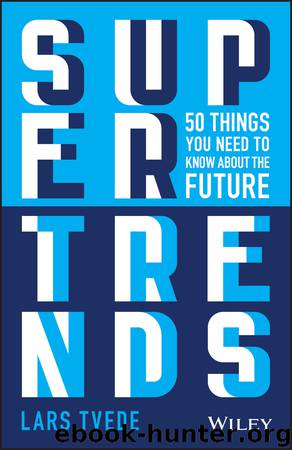Supertrends by Lars Tvede

Author:Lars Tvede
Language: eng
Format: epub
ISBN: 9781119646846
Publisher: Wiley
Published: 2019-12-09T00:00:00+00:00
Zinc 1992
2024
Copper 1995
2022
Gold 1983
2004
Silver 1987
2016
Natural gas 1996
2023
Oil 1994
2024
Mercury 1987
2015
So, according to the book's pessimistic scenario, by now – in fact, a long time ago – we would have run out of aluminium, zinc, copper, gold, silver, natural gas, oil, and mercury and, according to its optimistic scenario, we would have run out of gold, silver, and mercury by now and the other resources in just a few years’ time. In fact, by 2025, there would only be some aluminium left, and by 2030, that would be gone too.
But none of this either happened or is anywhere near happening. In fact, the total opposite happened.
The reason is innovation. In the mid-1990s, the American economist William Nordhaus, who incidentally has now been awarded the Nobel Prize for Economics, conducted a number of experiments involving various sources of light. First, he lit a bonfire, then a Roman oil lamp, then a light made of animal fat, and then a light of whale oil, while constantly measuring how many lumens – the units we use for measuring light – each source of light produced. Nordhaus wanted to clarify how much cheaper a light unit had become. The result was overwhelming. Imagine the work a Stone Age man had to invest in making a bonfire to produce light of reasonable quality for 54 minutes, when today modern man can produce light of the same intensity – for 52 years! This means that the so-called time-price – how much time you need to work in order to achieve a given material good – has dropped 500 000 times for light since the Stone Age!
And it is still falling rapidly. For example, there is now a global shift to LED, to which the following rule applies:
For every decade, the price per lumen (light unit) generated by LED decreases by a factor of 10, while the amount of light an LED unit can generate increases by a factor of 20 for a given wavelength (colour) of light (Haitz's Law).
Download
This site does not store any files on its server. We only index and link to content provided by other sites. Please contact the content providers to delete copyright contents if any and email us, we'll remove relevant links or contents immediately.
| Private Equity | Valuation |
| Venture Capital |
The Black Swan by Nassim Nicholas Taleb(7010)
Bad Blood by John Carreyrou(6546)
Pioneering Portfolio Management by David F. Swensen(6226)
Millionaire: The Philanderer, Gambler, and Duelist Who Invented Modern Finance by Janet Gleeson(4374)
Skin in the Game by Nassim Nicholas Taleb(4161)
Bullshit Jobs by David Graeber(4094)
The Money Culture by Michael Lewis(4075)
Skin in the Game: Hidden Asymmetries in Daily Life by Nassim Nicholas Taleb(3929)
The Wisdom of Finance by Mihir Desai(3650)
Blockchain Basics by Daniel Drescher(3504)
Liar's Poker by Michael Lewis(3367)
Fooled by Randomness: The Hidden Role of Chance in Life and in the Markets by Nassim Nicholas Taleb(3043)
Hands-On Machine Learning for Algorithmic Trading by Stefan Jansen(3027)
The Intelligent Investor by Benjamin Graham Jason Zweig(2995)
Mastering Bitcoin: Programming the Open Blockchain by Andreas M. Antonopoulos(2980)
The Power of Broke by Daymond John(2897)
Investing For Dummies by Eric Tyson(2894)
Market Wizards by Jack D. Schwager(2643)
Zero Hour by Harry S. Dent Jr. & Andrew Pancholi(2614)
